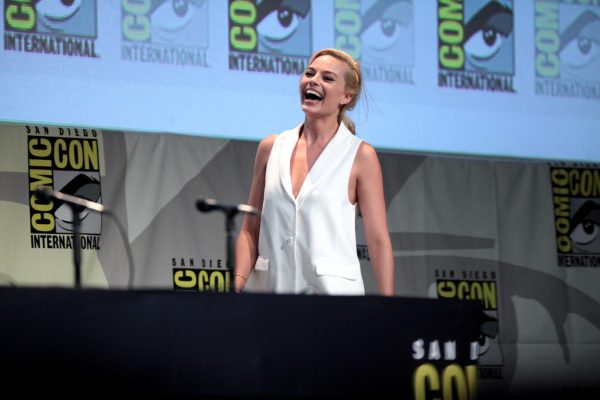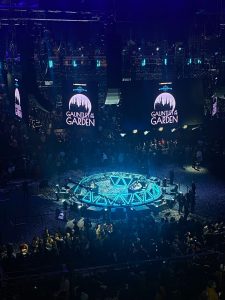“Suicide Squad:” Strong Females or Merely Sexy Superwomen?
Margot Robbie promoting “suicide Squad” at the 2015 San Diego Comic Con.(PHOTO COURTESY OF GAGE SKIDMORE VIA FLICKR)
September 1, 2016
One of the most anticipated films of the summer, David Ayer’s “Suicide Squad,” tanked with the critics but succeeded with most fans. Earning over $133.6 million in its first weekend, the film introduced fans to the infamous team of D.C. villains, including the ever-popular Harley Quinn (played by Margot Robbie), the assassin Deadshot (played by Will Smith) and Jared Leto’s much-anticipated Joker. But while some people loved watching the classic comic action and witty dialogue come to life on screen, many overlooked the over-sexualized nature of the female leads, especially Quinn herself.
Known in the comics as the crazy love interest of the Joker, Harley Quinn’s infatuation with the popular D.C. villain soars to new heights in “Suicide Squad,” which is not necessarily a good thing. Poorly developed throughout the entire length of the film, the only major arc her character has relates to her desperation to reunite herself with the Joker. Every flashback pertaining to Quinn in the film only explains her love affair with him, and the only time she truly embraces her own skin is when she thinks the Joker is dead. As viewers, we see Harley’s identity only linked to the Joker, and as a result learn nothing about her individuality.
the movie truly underutilized elements of Quinn that make her shine.
It seems apparent even in Quinn’s costuming that her entire identity is solely based on the Joker. Donning a bomber jacket with “Property of Joker” elegantly written on the back, over a “Daddy’s Little Monster” baseball tee and a choker necklace with “Puddin’” (Quinn’s nickname for the Joker) engraved on it, she appears more like his property than a person. In one particular scene, the Joker even offers to “give” her to a business associate while negotiating in a nightclub. Some dedicated fans may say that her abusive love affair with the Joker is what makes Harley Quinn, well, Harley Quinn. However, the movie truly underutilized elements of Quinn that make her shine, such as her raw, vulnerable side and emotional conflict pertaining to this tumultuous relationship.
In addition to her complete dependence on the Joker, let us not forget the blatant, over-sexualized nature Quinn embodies in the film. Known solely to the Joker as “the fire in [his] loins, the itch in [his] crotch,” Quinn uses her sexual appeal as her main asset to getting what she needs. From licking prison bars and complaining to male guards that she is “bored,” to providing her teammates with winks and flirty one-liners, viewers see more of the anti-hero’s seductive side than her true self. Truthfully, Harley Quinn is a woman who yearns to be loved—she uses her sexuality as a mechanism to hide her insecurities. The movie’s willingness to display only this over-sexualized side of the character for most of the film shows how underdeveloped she truly is. Quinn unfortunately falls into the trap where, like many leading ladies in modern cinema, her appeal is more important than who she really is, including her flaws and vulnerabilities.
The other female leads are not exempt to this blatant emphasis on their sex appeal. In fact, the costuming as a whole seems to over-sexualize all of the female leads. Instead of donning her classic red and black Harlequin jumpsuit, Quinn ditches it and chooses a ‘more-comfortable’ pair of pink and blue underwear and fishnets. The Enchantress (Cara Delevingne) wears nothing more than a black chain bikini, and even Katana wears a tight white crop top over what could have been a simple tank top. Their male counterparts are all covered up in their battle armor (because they are fighting, after all), and Leto’s Joker even wears a purple coat over his bare chest. Through this costuming, it seems that the men are the only ones to be taken completely seriously, because the women are strutting around and even fighting with an apparent emphasis on their bodies instead of their actual abilities.
The cinematography also guides the viewer to the not-so-discreet emphasis on the women’s appearances.
The cinematography also guides the viewer to the not-so-discreet emphasis on the women’s appearances. When Harley Quinn meets her Suicide Squad teammates, the men are all gearing up while she strips down to her red bra— a scene heavily promoted by an entire full body pan and placement in almost every trailer for the film. Let us not forget the other popular scene where she smashes a display front to reach for a purse inside, the camera subtly panning down so her underwear is a prevalent focal point. In most scenes when Katana draws her sword, the viewer’s eye is drawn to her midriff rather than the sword itself, and when Enchantress is casting a spell, her swaying hips is all we see for most of the movie. Meanwhile, the men are performing the actual action scenes with little to no sex appeal. When Deadshot loads a gun, he is loading a gun, and when the Joker threatens someone, he is meant to be terrifying—no strings attached. While the men on the squad are furthering the plot, the women seem to act only in ways that will further promote their sex appeal, and that is the blatant issue in the film.
With all of its potential to produce strong, female characters, Ayer’s “Suicide Squad” seems to focus solely on their appeal. Harley Quinn, engagingly performed by Robbie, is the epitome of a character ruined by the film to appear like nothing more than a man’s play toy. The other women are forced into the background, condemned by the writers to appear as the stereotypical females in comic franchises- somewhat strong but mostly used to allure viewers. Perhaps if the movie focused to create female characters that are as self-dependent and strong as the men, it might have had a better reception. And, if the writers chose to make them act naturally without over-sexualizing their movements and appearances, well, there would most definitely not be this problem.
This movie season, pay close attention to the representation of women. While “Suicide Squad” fell flat, there are other sci-fi movies to keep an eye on that seem to provide women with stronger characters. The upcoming superhero film “Doctor Strange,” opening in theaters Nov. 4, centers on Tilda Swinton’s wise and powerful character called “The Ancient One,” who guides and teaches Strange about his powers. And, let us not forget the widely-anticipated Star Wars spin-off, “Rogue One,” which opens on Dec. 16, starring Jyn Erso (Felicity Jones), a witty and fearless ex-convict who leads a Rebel team on a mission to obtain the blueprints to the infamous Death Star. Hopefully with the arrival of these films, the movie industry will begin to utilize women in more lead roles that strengthen them in the eyes of viewers everywhere instead of confining them to the background and using them only for their sexual appeal.














James Collinge • Sep 2, 2016 at 2:48 pm
Davis’s Amanda Waller is certainly ‘exempt.’
You haven’t mentioned her once, in spite of how she’s the driving force of the entire film.
As for Harley; her abusive and dependent relationship with the Joker has always defined the character, and the film never glorifies it. The people who sexualise her in the film are depicted as scumbags – she’s explicitly brain damaged.